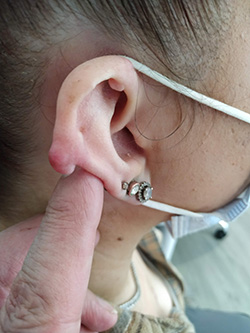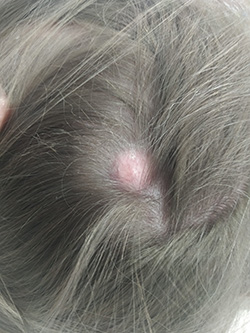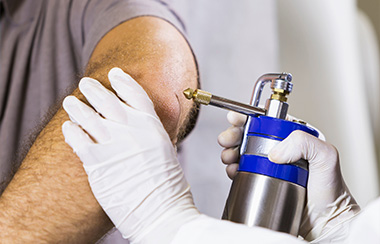HELPING
PATIENTS
MINOR SURGERY
Technically, Minor Surgery is any invasive procedure, performed without general anaesthesia in which only skin, mucus membranes and connective/fat tissue are resected. From a more practical point of view, minor surgery covers all those surgical procedures, performed under local anaesthesia, in an office-based setting, to remove and excise skin lesions and small lumps.
The most common lesions treated in minor surgery are:
- Skin tags;
- Warts and Verrucas;
- Benign moles and nevi, mainly for cosmetic reasons;
- Hairy moles;
- Crusting skin lesions;
- Vascular blemishes, like red spots or cherry angiomas;
- Xanthelasmas;
- Millia;
- Suturing of minor injuries;
- Removal of foreign objects;
- Incision and Drainage of infected lumps;
Sebaceous cysts; - Lipomas;
- Ingrown toenails.
 Lipoma scalp
Lipoma scalp
 Hypertrophic skin
Hypertrophic skin
 Sebaceous cyst scalp
Sebaceous cyst scalp
The demand for these treatments have skyrocketed as, in the UK, they are no longer commissioned by the NHS in some regions or the backlog is incredibly long, even years of waiting.
Some of these minor surgeries or minor operations can be performed by general practitioners (GP) and even cosmetic practitioners. However, for certain procedures, and to achieve best cosmetic and long lasting results, an experienced surgeon should be the preferred option
HOW ARE THESE MINOR OPERATIONS PERFORMED?
All of them are performed under some form of anaesthesia, either topical or injected, and most are done in the doctor’s office. If the anaesthetic agent is to be injected, a small needle will be used, to minimise the discomfort, and once the effect is achieved, the entire surgery will be done with no pain at all.
DIFFERENT TECHNIQUES CAN BE USED TO ACHIEVE THE EXCISION OF THE SKIN LESIONS:
Cryosurgery
 Cryosurgery
Cryosurgery
The lesion is frozen using special devices that will deliver liquid nitrogen to the area to be treated. This will produce a burn injury and the treated lesion will be turned into a scab, which will eventually fall off, leaving a new skin behind. Cryosurgery is quick, easy to perform, and does not need any anaesthesia. It is mainly used to treat warts and verrucas.
Electrocautery
 Using electrocautery for surgery
Using electrocautery for surgery
In this case, a device that delivers an electrical current, cuts and coagulates the lesion, so it can be shaved with no bleeding. Local anaesthesia is generally required, and after excision, a small black scab will appear. This scab may take several days to fall off, and the newly formed skin will be exposed. When proper care is taken, the cosmetic results are excellent, as there is no need for sutures.
Electrocautery, also known as hyfrecator, can also be used as an aid to perform more advanced minor surgeries, such as lipoma removal, helping to achieve a perfect haemostasis.
This method is mainly used to treat skin tags and pedunculated benign moles, but it is also useful to treat warts.
Plasma Surgery
Here, a radiofrequency current is used to treat the lesion. This so-called “plasma” produces a change in the protein structure which in turn will desiccate the lesion, which will eventually fall off. There are several devices in the market, working at different frequencies, and it is mainly used for the treatment of small lesions at delicate areas (such as eyelids), millia and xantelasmas.
Traditional Surgery
This is the traditional, standard surgery, where a blade is used to excise the lesion and sutures will be used to approximate the edges of the skin. This is the method of choice to treat cysts, lipomas, moles and when a pathology sample is required. It is performed under local anaesthesia, and, when the surgeon is knowledgeable and experienced, the cosmetic results could also be very good.
In most cases, skin sutures need to be removed 7 to 10 days after the minor operation. This is a pain free procedure and is usually performed by health care assistants.
 With one of my lipoma patients
With one of my lipoma patients


FREQUENTLY ASKED QUESTIONS
Can I get rid of my lumps and bumps with minor surgery?
Where are these minor surgeries performed?
Is minor surgery painful? Will I feel anything?
Do I need to fast or get a blood test before these minor surgeries?
Do I need to have my stitches removed or do they just fall off?
I am taking blood thinners. Can I still have my mole removed?
ABOUT DR. ALMEIDA
As a Consultant surgeon, Dr. Almeida has been treating skin lesions and lipomas for 2 decades, and he has personally performed thousands of these procedures at different clinics in Europe. He also teaches and trains medical professionals on minor surgery techniques. Therefore, if you need a skilled and expert professional to deal with your “bumps and lumps””, whether cosmetic or more medical. Dr. Almeida is your “go-to” expert.
To BOOK A FREE, NON-OBLIGATION CONSULTATION WITH DR. ALMEIDA, please CLICK THE BUTTON BELOW


